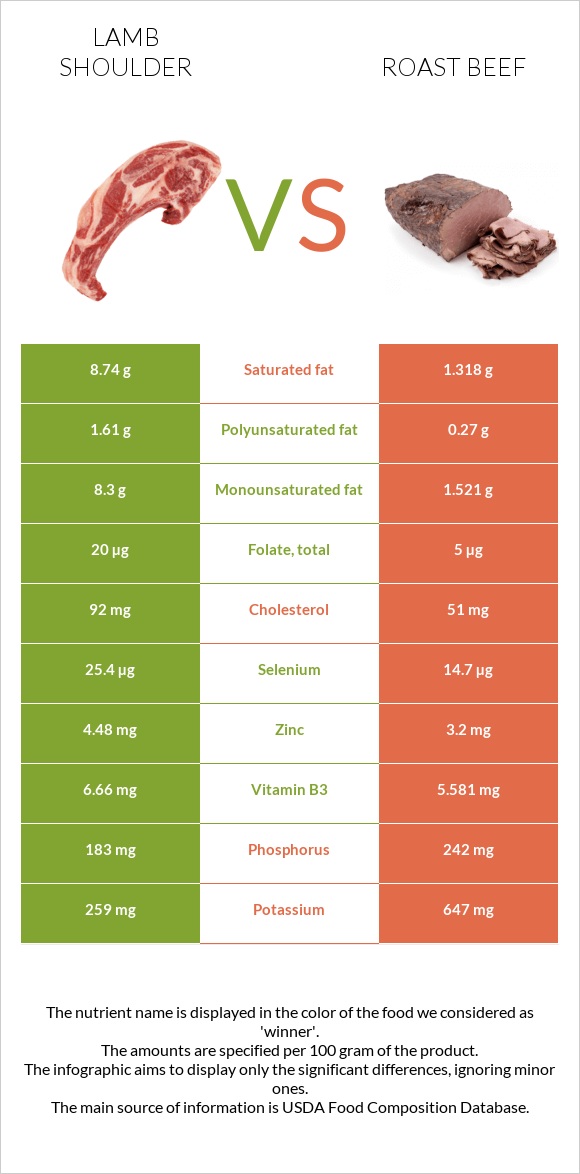Lamb shoulder vs. Roast beef — In-Depth Nutrition Comparison
Compare
How are lamb shoulder and roast beef different?
- Lamb shoulder is higher in vitamin B12, selenium, zinc, and vitamin B3; however, roast beef is richer in vitamin B6, potassium, and phosphorus.
- Daily need coverage for saturated fat for lamb shoulder is 37% higher.
- Lamb shoulder contains 2 times more cholesterol than roast beef. While lamb shoulder contains 92mg of cholesterol, roast beef contains only 51mg.
- Roast beef has less saturated fat.
Lamb, domestic, shoulder, arm, separable lean, and fat, trimmed to 1/4" fat, choice, cooked, roasted and Roast beef, deli style, prepackaged, sliced are the varieties used in this article.
Infographic

Infographic link
Mineral Comparison
Mineral comparison score is based on the number of minerals by which one or the other food is richer. The "coverage" charts below show how much of the daily needs can be covered by 300 grams of the food.
| Contains more MagnesiumMagnesium | +15% |
| Contains more CalciumCalcium | +260% |
| Contains more CopperCopper | +31.4% |
| Contains more ZincZinc | +40% |
| Contains less SodiumSodium | -92.4% |
| Contains more ManganeseManganese | +40% |
| Contains more SeleniumSelenium | +72.8% |
| Contains more PotassiumPotassium | +149.8% |
| Contains more PhosphorusPhosphorus | +32.2% |
Vitamin Comparison
Vitamin comparison score is based on the number of vitamins by which one or the other food is richer. The "coverage" charts below show how much of the daily needs can be covered by 300 grams of the food.
| Contains more Vitamin B1Vitamin B1 | +109.3% |
| Contains more Vitamin B2Vitamin B2 | +17.4% |
| Contains more Vitamin B3Vitamin B3 | +19.3% |
| Contains more Vitamin B5Vitamin B5 | +25.4% |
| Contains more Vitamin B12Vitamin B12 | +25% |
| Contains more FolateFolate | +300% |
| Contains more Vitamin AVitamin A | +∞% |
| Contains more Vitamin EVitamin E | +250% |
| Contains more Vitamin B6Vitamin B6 | +283.3% |
All nutrients comparison - raw data values
| Nutrient |  |
 |
DV% diff. |
| Sodium | 65mg | 853mg | 34% |
| Saturated fat | 8.74g | 1.318g | 34% |
| Vitamin B6 | 0.12mg | 0.46mg | 26% |
| Fats | 20.24g | 3.69g | 25% |
| Vitamin B12 | 2.55µg | 2.04µg | 21% |
| Selenium | 25.4µg | 14.7µg | 19% |
| Monounsaturated fat | 8.3g | 1.521g | 17% |
| Cholesterol | 92mg | 51mg | 14% |
| Zinc | 4.48mg | 3.2mg | 12% |
| Potassium | 259mg | 647mg | 11% |
| Polyunsaturated fat | 1.61g | 0.27g | 9% |
| Calories | 279kcal | 115kcal | 8% |
| Protein | 22.53g | 18.62g | 8% |
| Phosphorus | 183mg | 242mg | 8% |
| Choline | 43.9mg | 8% | |
| Vitamin B3 | 6.66mg | 5.581mg | 7% |
| Vitamin B1 | 0.09mg | 0.043mg | 4% |
| Folate | 20µg | 5µg | 4% |
| Copper | 0.113mg | 0.086mg | 3% |
| Vitamin B2 | 0.25mg | 0.213mg | 3% |
| Vitamin B5 | 0.71mg | 0.566mg | 3% |
| Vitamin E | 0.14mg | 0.49mg | 2% |
| Magnesium | 23mg | 20mg | 1% |
| Calcium | 18mg | 5mg | 1% |
| Vitamin K | 1.6µg | 1% | |
| Net carbs | 0g | 0.64g | N/A |
| Carbs | 0g | 0.64g | 0% |
| Vitamin D | 1 IU | 0% | |
| Iron | 2.03mg | 2.05mg | 0% |
| Sugar | 0.29g | N/A | |
| Vitamin A | 0µg | 3µg | 0% |
| Manganese | 0.021mg | 0.015mg | 0% |
| Trans fat | 0.148g | N/A | |
| Tryptophan | 0.263mg | 0% | |
| Threonine | 0.964mg | 0% | |
| Isoleucine | 1.087mg | 0% | |
| Leucine | 1.753mg | 0% | |
| Lysine | 1.99mg | 0% | |
| Methionine | 0.578mg | 0% | |
| Phenylalanine | 0.917mg | 0% | |
| Valine | 1.216mg | 0% | |
| Histidine | 0.714mg | 0% | |
| Omega-3 - EPA | 0.007g | N/A | |
| Omega-3 - DHA | 0.001g | N/A | |
| Omega-3 - ALA | 0.017g | N/A | |
| Omega-3 - DPA | 0.012g | N/A | |
| Omega-6 - Gamma-linoleic acid | 0.001g | N/A | |
| Omega-6 - Dihomo-gamma-linoleic acid | 0.011g | N/A | |
| Omega-6 - Eicosadienoic acid | 0.002g | N/A | |
| Omega-6 - Linoleic acid | 0.14g | N/A |
Macronutrient Comparison
Macronutrient breakdown side-by-side comparison
Protein:
22.53 g
Fats:
20.24 g
Carbs:
0 g
Water:
55.92 g
Other:
1.31 g
Protein:
18.62 g
Fats:
3.69 g
Carbs:
0.64 g
Water:
73.72 g
Other:
3.33 g
| Contains more ProteinProtein | +21% |
| Contains more FatsFats | +448.5% |
| Contains more CarbsCarbs | +∞% |
| Contains more WaterWater | +31.8% |
| Contains more OtherOther | +154.2% |
Fat Type Comparison
Fat type breakdown side-by-side comparison
Saturated fat:
Sat. Fat
8.74 g
Monounsaturated fat:
Mono. Fat
8.3 g
Polyunsaturated fat:
Poly. Fat
1.61 g
Saturated fat:
Sat. Fat
1.318 g
Monounsaturated fat:
Mono. Fat
1.521 g
Polyunsaturated fat:
Poly. Fat
0.27 g
| Contains more Mono. FatMonounsaturated fat | +445.7% |
| Contains more Poly. FatPolyunsaturated fat | +496.3% |
| Contains less Sat. FatSaturated fat | -84.9% |





